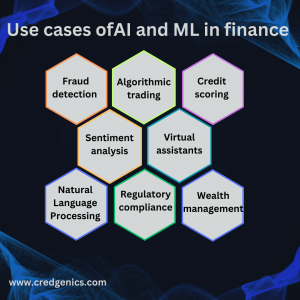Artificial Intelligence(AI) and Machine Learning ( ML) continue to transform millions of lives globally and reshape the way people go about their activities, including managing their finances. AI and ML in finance have made transactions more user-friendly, facilitated simpler professional assistance, and provided 24/7 access to banking services by integrating new capabilities within the financial sector. Additionally, the recent developments in generative AI have made new business opportunities available for financial services.
The AI market in India is poised for significant growth, with projections indicating that it will reach a substantial value of US$ 7.8 billion by 2025. This rapid market expansion underscores the increasing adoption and integration of artificial intelligence across various sectors. Businesses, government organizations, and industries are recognizing the transformative potential of AI technologies, from improving operational efficiency and enhancing customer experiences to addressing complex challenges.
There are several recent applications that are becoming successful use cases of AI and ML in finance and promise to open new areas of growth.
Use case 1: Fraud detection and prevention
AI and ML models play a crucial role in real-time fraud detection. They analyze transaction data to spot irregularities and uncommon patterns that might be indicative of fraudulent activities. These models continually refine their capabilities by assimilating fresh data, ensuring they stay effective against evolving fraud tactics. This dynamic approach enhances security for both consumers and financial institutions, safeguarding against potential threats in the ever-changing landscape of financial security.
Use case 2: Credit scoring and risk assessment
Traditional credit scoring models have a significant limitation in that they tend to overlook individuals with limited or no credit histories. This exclusion can affect various groups, including young adults who are just starting to build their credit profiles and individuals in emerging economies who may not have had access to formal financial services. However, machine learning algorithms have introduced a transformative change by taking a more comprehensive approach to credit assessment, making it one of the most interesting AI use cases in financial services.
These ML models can consider a broader spectrum of data points, including online behavior, transaction histories, and even alternative data sources, such as utility payments or rental history. By doing so, they can offer a more holistic view of an individual’s financial positioning and creditworthiness. This enhanced perspective enables financial institutions to extend credit to a more diverse customer base while still managing risk effectively. In essence, machine learning algorithms help bridge the credit gap and make financial services more accessible to individuals who may have been underserved or excluded by traditional credit scoring methods.
Use case 3: Chatbots and virtual assistants
AI-powered chatbots and virtual assistants have significantly elevated the customer service experience within the financial services industry. These smart bots are designed to offer instant responses to customer inquiries and manage routine tasks efficiently. Whether it’s checking an account balance, transferring funds between accounts, or even answering frequently asked questions, AI-driven chatbots are available around the clock, providing customers with the convenience of immediate assistance.
This 24/7 availability is a game-changer for customer service. Customers no longer need to wait for business hours or endure long call center queues to get the help they need. This not only enhances customer satisfaction but also reduces operational costs for financial institutions. The automation of routine tasks through AI chatbots allows human agents to focus on more complex and value-added interactions, creating a win-win situation for both customers and financial organizations.
Use case 4: Regulatory compliance and risk management
AI and ML in finance have emerged as valuable tools for financial institutions grappling with complex regulatory environments. One of their key roles is automating compliance tasks, particularly in areas like Anti-Money Laundering (AML) and Know Your Customer (KYC) checks. By deploying AI-driven algorithms, financial organizations can efficiently process vast amounts of data, identify suspicious patterns, and ensure regulatory compliance. This not only enhances the accuracy and thoroughness of compliance checks but also significantly reduces the time and resources required to meet these regulatory obligations.
AI and ML models facilitate a more comprehensive assessment of market and operational risks. These technologies can analyze data from various sources, including market trends, historical performance, and operational practices. By doing so, they provide financial institutions with insights that help make more informed decisions. This risk assessment capability is vital in managing and mitigating potential threats, ensuring the stability and security of the financial system. As financial markets and risks evolve, AI and ML offer continuous monitoring and analysis, enabling organizations to adapt swiftly to emerging challenges and opportunities.
Use case 5: Sentiment analysis and market prediction
AI algorithms have enriched market analysis by incorporating a wide range of data sources into their predictive models. They analyze not only traditional financial data but also news articles, social media discussions, and market sentiment. By considering this vast amount of unstructured data, AI models can offer insights into market trends and investor sentiment that were previously challenging to discern. This comprehensive approach enables traders and investors to make data-driven decisions with a more profound understanding of the market landscape.
As a result, market participants can reduce risks and better capitalize on emerging opportunities. AI-driven market trend predictions have the potential to provide a competitive edge, allowing traders to act swiftly based on real-time insights. Moreover, by aligning investment strategies with these AI-generated forecasts, investors can achieve more successful outcomes and optimize their returns, ultimately improving their overall financial well-being. AI’s ability to process vast datasets and identify patterns, coupled with its capacity to provide predictive analytics, has significantly elevated the accuracy and effectiveness of decision-making in the financial sector.
Use case 6: Natural Language Processing (NLP) for data extraction
Natural Language Processing (NLP) algorithms play a pivotal role in transforming unstructured data into actionable insights for financial institutions and investors. These algorithms have the capability to process vast amounts of text data from sources like news articles, financial reports, social media, and more. By doing so, NLP extracts valuable information and identifies patterns, sentiments, and trends that might otherwise remain buried in the overwhelming volume of textual data. This newfound understanding of textual information can be utilized to inform investment strategies and decision-making processes.
One of the notable advantages of NLP is its ability to gauge market sentiment accurately. By analyzing news articles and social media discussions, NLP can assess public and investor sentiment regarding specific assets or the market in general. This sentiment analysis can provide critical insights that influence investment decisions, risk management, and market positioning. Additionally, NLP can aid in evaluating the performance of various assets and predicting potential market movements based on textual cues. It enables financial professionals to stay well-informed, make data-driven decisions, and adapt their strategies to ever-changing market conditions.
Use case 7: Wealth management and personalized recommendations
AI-driven wealth management platforms have revolutionized the investment landscape by leveraging machine learning (ML) to offer a highly personalized experience. These platforms take into account a wide array of factors, including an individual’s financial goals, risk tolerance, and market dynamics. By continuously analyzing customer preferences and market conditions, these systems generate tailored investment recommendations. This approach not only allows clients to receive advice that aligns with their unique financial objectives but also empowers them to make well-informed investment decisions.
The differentiating factor of these AI-powered platforms lies in their ability to adapt and learn over time. As customers interact with the system and their financial situations evolve, the AI algorithms adjust their recommendations accordingly. This dynamic, data-driven approach ensures that clients remain well-informed and can adapt their investment strategies in response to changing circumstances or market conditions. It’s like having a personal financial advisor who’s always up-to-date and focused on your best interests.
Use case 8: Algorithmic trading
AI-driven algorithms have sparked a profound transformation in the trading landscape. They excel at executing intricate strategies with remarkable speed, far surpassing the capabilities of human traders. The massive amounts of historical data that these machine learning models are built to process, combined with real-time inputs like news and market sentiment, results in instantaneous, data-driven decisions that are precisely calibrated to optimize trading strategies and maximize returns.
AI-driven trading systems can find opportunities, correlations, and hidden market trends that might escape human traders thanks to their ability to process and interpret these various data sources. By continuously learning from new data, these models remain agile and adaptable in the face of evolving market conditions, providing traders with a powerful tool to stay competitive and secure a potential edge in the dynamic world of financial markets.

Conclusion
AI and ML are catalysts for profound changes in the financial industry, going beyond the eight use cases mentioned. Their impact extends into nearly every facet of the sector, fundamentally reshaping the way financial institutions operate and serve their customers. The transformative power of these technologies lies in their ability to improve efficiency, streamline operations, and enhance the overall customer experience.
By automating routine tasks, optimizing trading strategies, providing personalized investment advice, and aiding in compliance with ever-evolving regulations, AI and ML have made financial processes more efficient, cost-effective, and responsive to market dynamics. These technologies also facilitate more accurate risk assessments, enabling institutions to make well-informed decisions regarding lending, investments, and fraud prevention. In essence, AI and ML are not just tools but the cornerstones of a modern financial landscape.
As these technologies continue to advance and evolve, financial institutions that embrace AI and ML innovations are poised to remain competitive and agile in the ever-evolving financial landscape. They will be better equipped to meet the diverse and dynamic needs of their customers while ensuring operational efficiency and compliance with regulatory standards. The journey of transformation through AI and ML in finance is ongoing, and its potential to transform finance remains substantial.
If you are looking to transform your debt collections strategy with the power of digital and data-powered insights, reach out to us to request an exploratory session at sales@credgenics.com or visit us at www.credgenics.com
FAQs:
- What is the primary benefit of using AI and ML for fraud detection in finance?
The primary benefit of AI and ML in fraud detection is their ability to provide real-time protection against fraudulent activities. These technologies analyze transaction data continuously, identifying anomalies and unusual patterns as they occur. By doing so, AI and ML models can alert financial institutions promptly, enabling them to take immediate action to prevent or mitigate potential fraud attempts. This real-time detection significantly enhances security in financial transactions, reducing the likelihood of financial losses and protecting both consumers and financial institutions.
- How do AI-driven chatbots and virtual assistants improve customer service in the finance industry?
AI chatbots and virtual assistants play a crucial role in enhancing customer service in finance. They provide instant responses to customer inquiries, making assistance available 24/7. These AI-powered tools can handle routine tasks such as balance inquiries, fund transfers, and general information requests. By offering this level of accessibility and quick responses, they substantially improve customer satisfaction. Moreover, they reduce operational costs for financial institutions by automating routine tasks, allowing human agents to focus on more complex customer interactions and issues that require personalized attention. In essence, AI-driven chatbots and virtual assistants offer both convenience and efficiency, benefiting both customers and financial institutions.
- Why are AI-based credit scoring models considered superior to traditional ones?
AI-based credit scoring models are considered superior due to their ability to leverage a broader range of data sources, offering more accurate credit assessments. Traditional credit scoring models primarily rely on limited data points, such as past credit history. AI algorithms, however, can consider a wider spectrum of information, including online behavior, transaction histories, and even alternative data sources like social media activity. This comprehensive data analysis enables more precise credit assessments, allowing financial institutions to make informed lending decisions. It also benefits consumers with limited or no traditional credit history, as they can be evaluated based on their digital footprint. By considering a more extensive dataset, AI-driven models enable financial institutions to provide loans to a diverse customer base while effectively managing risk.
- How do AI and ML-powered wealth management platforms provide personalized investment advice?
AI and ML-powered wealth management platforms offer personalized investment advice by analyzing a combination of customer-specific data, risk tolerance, and market conditions. These platforms employ advanced algorithms to identify the most suitable investment options for individual clients. They take into account not only traditional factors like financial goals and risk appetite but also real-time market conditions and emerging trends. This dynamic approach allows clients to receive investment recommendations that are tailored to their specific needs and the current market landscape. By providing personalized advice, AI-driven wealth management platforms empower clients to make informed investment decisions that align with their financial goals and the ever-changing market conditions.
- Can you explain the role of AI in risk assessment and regulatory compliance within the finance sector?
AI plays a vital role in risk assessment and regulatory compliance within the finance sector by providing automation, efficiency, and accuracy. In terms of risk assessment, AI algorithms can analyze vast amounts of data, including market trends, operational data, and historical information, to evaluate various types of risks, such as market risk and operational risk. These assessments help financial institutions make more informed decisions regarding their investment strategies and risk management practices. When it comes to regulatory compliance, AI is instrumental in automating tasks like Anti-Money Laundering (AML) and Know Your Customer (KYC) checks. AI systems can efficiently process large volumes of data and compare it against regulatory requirements, making compliance checks faster and more reliable. Additionally, AI assesses market and operational risks to assist organizations in creating strategies for minimizing potential risks and optimizing financial performance. AI-driven risk assessments and compliance checks are indispensable in today’s finance sector, ensuring both regulatory adherence and risk management.




